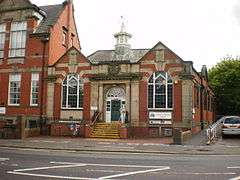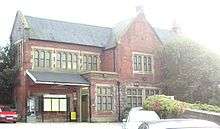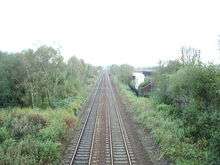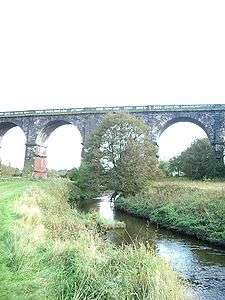Newton-le-Willows
| Newton-le-Willows | |
|---|---|
| Town | |
 Newton-le-Willows library | |
 Newton-le-Willows | |
| Newton-le-Willows shown within Merseyside | |
| Population | 22,114 (2011 Census) |
| OS grid reference | SJ580949 |
| • London | 171 mi (275 km)[1] SE |
| Metropolitan borough | |
| Metropolitan county | |
| Region | |
| Country | England |
| Sovereign state | United Kingdom |
| Post town | NEWTON-LE-WILLOWS |
| Postcode district | WA12 |
| Dialling code | 01925 |
| Police | Merseyside |
| Fire | Merseyside |
| Ambulance | North West |
| EU Parliament | North West England |
| UK Parliament | |
Newton-le-Willows is a market town in Merseyside, England. Historically part of Lancashire, it is midway between Liverpool and Manchester, about 15 miles (24 km) from each, 4 miles (6 km) east of St Helens, 5 miles (8 km) north of Warrington and 7 miles (11 km) south of Wigan. The population at the 2011 census was 22,114.[2]
History
The name Newton means "new town", while Makerfield is an ancient name for the district from a pre-English word meaning "wall", and the English word "field".[3] Neweton was mentioned in the Domesday Book. "In Makerfield" was added to distinguish it from other Newtons and recorded as Makeresfeld in 1205 and 1351, as Makefeld in 1206, Makerefeld in 1213 and Makerfield since 1242.[4]
Before the Norman conquest, Newton was head of a hundred. The Domesday hundred was assessed at five hides one of which included Newton. The lord of the manor was Edward the Confessor at his death in 1066. The Newton Hundred was subsequently combined with the Warrington and Derby Hundreds to form the West Derby Hundred.[3][4]
It was an agricultural village, albeit with borough status, until the arrival of the railways in 1830. There was some industry: there are five cotton spinners recorded in an 1825 directory. However, it was the coming of the railways that transformed a small village into the world's first "railway town", although places such as Crewe, Derby and Swindon soon overtook Newton in size and importance. The town also developed into a major coal mining area, being on the South Lancashire Coalfield.
The fields between Newton and Winwick were the site of one of the last battles of the Second English Civil War.[5][6]
Railway town



Newton's history since the 19th century has been very closely linked with the railway industry. The Vulcan Foundry was opened in 1831 and later developed into one of the world's foremost locomotive manufacturers. Vulcan Village, the southernmost suburb of Newton was developed to house workers from the foundry and has in recent years become a conservation area.
The western area of the town, Earlestown also developed with the coming of the railways. Earlestown was also built as a factory village, but for the Viaduct Foundry, which later became the London and North Western Railway's principal waggon works. Since Victorian times, Earlestown has been the fastest-growing area of the town, and thus Newton-le-Willows' town centre is situated in Earlestown. Between Earlestown and the Vulcan Village is the largely residential suburb of Wargrave.
William Huskisson, Member of Parliament for Liverpool and an early supporter of railways, was killed at Parkside near Newton when he was run down by Stephenson's Rocket locomotive on the opening day of the Liverpool and Manchester Railway. There is a memorial at the spot where the accident happened. A modern bridge in the town centre is named in memory of Huskisson.
Newton has two historic railway stations. Newton-le-Willows railway station is in the old original part of town and Earlestown railway station, opened in 1830. They are two of the oldest railway stations in existence. Earlestown was an important junction where the original Liverpool and Manchester line was joined by the 1837 line running south to Birmingham. The town has also had three other railway stations, situated at Parkside, where Huskisson's fatal railway accident happened, at the Vulcan Village and one serving the old racecourse, closed when Haydock Park Racecourse was opened. Two other local railway related landmarks are Newton Viaduct and the Sankey Viaduct which is locally known as the "Nine Arches".
Other industries
The town also had other industries: sugar refining, chemicals, glass, biscuit manufacturing machinery and coal mining. Parkside Colliery opened in the 1960s with an expected lifespan of 100 years but closed in 1992. The colliery hit the national headlines due to demonstrations against its closure. The closure of Parkside marked an end to Lancashire's centuries old coal industry. The town is the home of the head office of Nicholls Foods, the makers of Vimto soft drinks.
Governance
Forming part of the historic county boundaries of Lancashire from a very early time, Newton-le-Willows is an ancient town having been mentioned in the Domesday Book. It was initially part of the Fee of Makerfield, which was part of the West Derby hundred. It was later made a parliamentary borough from 1558 until 1832, one of the earliest in Lancashire. From this date until 1894, the town came under the control of a Court Leet and Improvement Commissioners. The developing industrial town was then created into an urban district under the name Newton in Makerfield. The name of the urban district was changed in 1939 to Newton-le-Willows. On 1 April 1974 it lost its independence when Newton-le-Willows Council merged with a number of neighbouring local authorities, to create St Helens Metropolitan Borough Council.[7]
Newton-le-Willows is split into two wards, Newton and Earlestown, each ward returns three councillors to serve on St Helens Borough Council. As of April 2015 all six ward councillors represented the Labour Party.
Geography
Newton stands in the centre of the large Greater Manchester and Merseyside conurbation. It is a small market town in North West England on the western edge of Chat Moss. The town consists of four districts, Earlestown, Wargrave, Vulcan Village and the ancient Newton in Makerfield area, that makes up the eastern part of the town.
Two town centres
The old centre of Newton is on the A49 road (formerly the Warrington-Wigan Turnpike Road) and has a number of Georgian buildings, and is an attractive residential area. The High Street area has a village appearance with small local shops serving the local area. There used to be a street market outside the parish church, which in the 1890s was moved to Earlestown. The old town hall was demolished some years ago after serving as a civic hall.
With the Industrial Revolution, the area of Earlestown developed about a mile west of the original Newton centre. As this part of the town grew, amenities were moved to Earlestown from Newton. As the market was moved to Earlestown and a new town hall was built to house the old Newton council, the new town centre became based on Earlestown. During recent years the town hall in Earlestown has been allowed to some extent to fall into a poor state of repair, it has recently been registered as a grade II listed building.
Shopping centre
The town centre is now based in the Earlestown district of the town, with its main shopping street, Market Street, being pedestrianised during the 1980s. Bridge Street, Oxford Street, Queen Street and Earle Street make up the shopping area (Earle Street was formerly named Pepper Alley Lane up to the late 19th century).
The market is a major attraction for people from the surrounding areas. There are many small long established independent retailers although the number of national retail organisations in the town is increasing. As with other towns, many larger retail stores have closed, such as Woolworth's in 2009 and Safeway due to the companies ceasing trading. The large Somerfield and Co-op town centre stores have closed due to those companies merging, however the Co-op has a small store in the Wargrave area of the town. A positive sign for the town is how these larger premises were relet to other national retailers. Tesco acquired the Safeway store, Wilkinson's took over the former Somerfield store and the former Co-op superstore was subdivided into a number of units which provided the town with a new main post office, Netto supermarket, Morrisons supermarket and Store Twenty One clothing store. The former Woolworth's store soon reopened as Heron Frozen Foods, a fast-growing Yorkshire-based food retailer. Other major national retailers to have opened in the town recently include Superdrug, McDonald's, Shoe Zone and Card Factory. The town also has a number of other long-established national companies like Boots, Greggs bakers and most of the major banks. Whiston Motor Factors have taken over the old Fred Morts jewellers in Oxford Street, and there are a number of free car parks in the town centre. Another small retail area exists at Park Road South in the Wargrave area of the town, with the small Co-op supermarket. Also in Earlestown there are some private IT shops.
Transport
The M6 and M62 motorways, and also the A580 East Lancashire Road pass close to the town. This has helped Newton become an important commuter town now that most of its industry has gone. There have been many new housing estates built around the outskirts of the town.
England's first operational canal, the Sankey Canal passes through the town and is crossed, on the Sankey Viaduct, by the world's first passenger railway, also within the boundaries of the town.
Newton-le-Willows and Earlestown railway stations have a good regional service with regular trains running to Liverpool and Manchester, St Helens, Warrington, Chester, West Yorkshire and along the North Wales coast to Llandudno. Earlestown is a very large station for the size of the town, with 5 platforms. On platform 2 is the old waiting room, regarded as one of the oldest remaining railway buildings.
There is a small bus station in Tamworth Street, with a number of bus routes running around the town, and out of town services connecting neighbouring Burtonwood, Haydock, Ashton-in-Makerfield, Lowton, Garswood and major towns of Warrington, St. Helens, Wigan and Leigh.
Religion
Once part of the ancient parish of Winwick, the town is split into four Anglican parishes, St Peter's covering Newton, St John's covering Earlestown, Emmanuel covering Wargrave and All Saints' covering the northern parts of the town.
Similar to other towns in Lancashire, Newton has a large Roman Catholic population and there are three Catholic churches in the town, St Patrick's in Earlestown, St Mary and St John's in Newton and St David's in Wargrave.
There are also many other denominations represented in the town, such as the Methodist and Baptist churches in the town centre.
In 2013 the first Muslim community centre was established located at 9 Queen Street, nearby Earlestown Railway Station.
Local media
From Victorian times until 2007, the town had a number of local newspapers. The Newton and Golborne Guardian was the longest established, which ceased publication in 2007. Other papers to have served the town over the years include the Earlestown Guardian, and Newton Reporter. The town comes within the distribution area of the St Helens Star and St Helens Reporter, both free newspapers. The Warrington Guardian, Liverpool Echo, Manchester Evening News and Wigan Evening Post are widely available within the town.
Local radio is provided by WA12 RADIO an internet-based radio station, founded in 2011 and is now part of Newton Boys and Girls Club. Regional radio is provided by Heart North West, BBC Radio Merseyside and BBC Radio Manchester.
The town falls within the North West region for the BBC and Granada region for ITV.
Sport
Newton-le-Willows racecourse closed down in 1898 and was replaced by Haydock Park Racecourse. The Old Newton Cup is the world's oldest continually competed for trophy, with a history dating back over 200 years.
Football has always been an important sport within the town, and Newton-le-Willows had its own club between 1894 and 1908. Newton-le-Willows F.C. played in the local leagues until the 1900-01 season when the club joined the English Combination where they competed for three years. In 1903-04 season the club joined the Lancashire Combination where their derby matches included Bryn Central and Wigan Town (a forerunner of Wigan Athletic). The club left the league at the end of the 1907-08 season at which point the club folded. Newton-le-Willows home ground was the Pied Bull Ground which was situated behind the public house of the same name and bordered Rob Lane (then Golborne Road), more or less where the Parchments estate lies. There has been a couple of spells that Earlestown Football Club has been quite successful. The team competed in the Lancashire Combination league which at the time (1950s/1960s) was the equivalent of today's Northern Conference. Earlestown enjoyed a local rivalry with a number of teams which would go on to national prominence, especially Wigan Athletic. Earlestown was a very ambitious club who hit the headlines when they signed Wilf Mannion as player manager. Crowds of one or two thousand were not unknown for local derbies. However, falling gates and the cost of a professional squad forced the club into bankruptcy in the mid 1960s. In its earlier history, Earlestown F.C. created a few pieces of history, including being defeated by Everton in the Liverpool Cup which was the Toffees' first cup final victory. A year later, Earlestown won the final beating an Everton side that would help form the football league just three years later. Earlestown also played Everton in the first ever match at Anfield stadium.[8] A number of smaller teams operate in the town, the most prominent being Vulcan Newton FC who have previously been in the Lancashire Combination and North West Counties League.
This area is a hotbed for rugby league with St Helens, Warrington, Widnes, Wigan and Leigh being neighbouring towns, however the town never had a rugby league team until recently, when in 2002, Newton Storm ARLFC was formed. Storm has become one of the fastest-growing amateur rugby league clubs in the north west. Rugby union was historically the most popular code in this town, with two teams, Newton-le-Willows RUFC and Vulcan RUFC being prominent teams in the South Lancashire and Cheshire leagues. The most prominent players in the past have been former England and British Lions international Fran Cotton, and Wigan player Steve Hampson.
Cricket is now the major sport in the town, with Newton C.C. playing in the Premier Division of the Liverpool Competition, a major north west league with teams stretching from the Fylde coast to North Wales competing in it. Vulcan C.C. also represent the town on a more localised level. Newton has produced a number of players who have progressed onto Lancashire County Cricket Club.
Notable people
- Rick Astley, pop star, most known for "Never Gonna Give You Up" which spawned the internet meme of "rickrolling".
- Andy Burnham, Leigh MP, former government minister, Labour leadership candidate and Shadow Home Secretary was educated at St Aelred's High School in Newton. He was elected as Mayor of Greater Manchester in 2017.
- Ed Clancy, Olympic Gold Medalist for Great Britain in the Team Pursuit event at Beijing 2008
- Fran Cotton, started playing for Newton RUFC before moving onto to Sale, England and the British Lions; he runs the Cotton Traders sportswear firm in nearby Altrincham
- Joe Fagan, the former Manchester City player and European Cup–winning Liverpool F.C. manager, who resigned his post after the Heysel disaster started his career playing for Earlestown Bohemians FC in the 1930s
- George Formby, then an unknown local comedian from Wigan, made his first stage appearance (as George Hoy) at the Hippodrome Theatre, Earlestown, Newton-le-Willows
- Norman Harvey, awarded the Victoria Cross during the First World War for bravery on the field of battle.
- Roger Hunt, former Liverpool and England World Cup–winning footballer, was born in the neighbouring village of Culcheth; his family's business Hunt Brothers Haulage is based in Newton-le-Willows
- Martin Kelly, current Crystal Palace and England U-21 international was brought up and lives in Newton
- Lynda La Plante, author, screenwriter and former actress, was born on 15 March 1943 in Newton-le-Willows
- Wilf Mannion, former Middlesbrough and England winger was the manager of the town's most successful football club, Earlestown F.C. between 1960 and 1962
- Rodney Porter, scientist, won a Nobel Prize in 1972
- John Randall, scientist, the developer of the Magnetron used in Radar Systems, was born on 23 March 1905 in Newton-le-Willows
- Pete Waterman, the famous record producer, is a former resident of the town, and appropriately having once lived there has a famous interest in old railways
- Colin Welland, writer and actor, won an Oscar for writing the script of the film Chariots of Fire
References
Notes
- ↑ "Coordinate Distance Calculator". boulter.com. Retrieved 8 March 2016.
- ↑ "Town population 2011". Retrieved 13 January 2015.
- 1 2 Newton in Makerfield, Nottingham University, retrieved 4 March 2015
- 1 2 Farrer, William; Brownbill, J (editors) (1911), "Newton in Makerfield", A History of the County of Lancaster, Volume 4, Victoria County History, pp. 132–137, retrieved 3 March 2015
- ↑ Freeling, Arthur (1838), Freeling's Grand Junction Railway companion to Liverpool, Manchester, and Birmingham, Whittaker, p. 30
- ↑ Steven Dowd. "The Battle of Winwick Pass, 19 August 1648". Retrieved 2010-04-20.
- ↑ Newton-le-Willows, A Vision of Britain Through Time, retrieved 25 October 2005
- ↑ Dowd, Steven. "Some Earlestown Sporting History". www.newton-le-willows.com. Retrieved 9 November 2011.
Bibliography
- Liverpool & Manchester Railway 1830–1980, Frank Ferneyhough, Book Club Associates, London, 1980, (no ISBN)
External links
| Wikimedia Commons has media related to Newton-le-Willows. |
